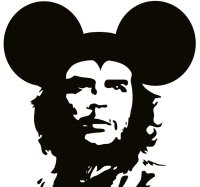Agam's Gecko


Monday, December 15, 2008
REVOLUTIONARY CHEEK
 Benicio del Toro displays the deeply passionate Ché head-tilt look in his new movie. |
| Y |
our humble correspondent never actually had one of those iconic two-tone posters of Ernesto "Ché" Guevara during my young and foolish days; neither did I own one of his t-shirts. But I did think of him as cool and heroic, while actually knowing next to nothing about the man.
My best friend in high school, an artist, got very much into silkscreening around 1970, and I couldn't begin to guess how many copies of the Ché poster we made in his basement. What follows is a bit of inadequate atonement for our gullibility and uninformed hero worship.
Revolutionary chic certainly remains a popular brand among the cultural elites of Hollywood. A photo compilation of famous stars wearing Ché pendants or brandishing Chairman Mao handbags (perhaps tipping back some tasty Ché Lager at the trendy Mao's Kitchen restaurant) would probably not contain too many surprises. Why is it considered cool for pampered celebrities to glorify communist killers like those two, and way cool to make hagiographic movies about them? Benicio del Toro portrays the Argentinian-born revolutionary in a brand new movie, for which he has already been lauded from Cannes to Havana. Director Steven "Sex, Lies and Videotape" Soderbergh:
"Che’s dream of a classless society, a society that isn’t built on the profit motive, is still relevant. The arguments still going on are about his methodology."The "renowned auteur" (as per this pathetically grovelling Politico writer) hasn't actually any clue what Guevara dreamed about, and what he actually helped Fidel create is anything but "classless." Methodology? Stay tuned. The important thing, says renowned auteur, is passion.
"What I hope happens when people come out of the theater is they’ll ask themselves, 'Wow, is there anything in my life I feel that passionate about?'"Wow, what did Ché feel that passionate about? And how can I apply this to my commitment to the Global War on CO2 Molecules, or impeaching Chimpy Bushitler in the next five weeks?
Here is a short film about Ché's passion, and the misplaced passion for Ché and Mao products by those who should know better. Written and produced by Ted Balaker for Reason Magazine: Killer Chic.
[Press the button, and pause when it starts loading. Keep reading, and it will be ready to view uninterrupted when you finish.]
Wai to David Thompson for noticing this mini-documentary about the "suckers who fellate this 'social justice' icon." This group includes a surprising number of artists and musicians (Guevara hated artists and musicians). Before my friend and I were busy running off iconic Ché posters -- between runs of similarly two-toned iconic posters of the Fab Four (the portraits from the White Album) -- young Beatles-loving Cubanos were being branded as roqueros and shipped off to the detention camps. Jazz, rock and roll, these were prohibited to Cubans as "imperialist music."
Ché's first job in revolutionary Cuba was as the comandante of a political prison located in an old stone fortress, San Carlos de La Cabaña. He soon acquired the nickname "Butcher of La Cabaña" due to his strong enthusiasm for executions, many of which he carried out personally.
His office overlooked the execution grounds, and it is said that the wasteful blood-letting disturbed him. The wastefulness, that is, not the blood-letting. So he ordered the condemned to "donate" on the way to the firing squad. Surviving inmates of La Cabaña prison have described that many were then too weak to walk to their executions, and needed to be carried on stretchers.
 El Ché gets the mickey. Image: The Dissident Frogman |
Guevara is reported by several of his former underlings to have demanded no delays with the proceedings, admonishing: "This is a revolution. Do not use bourgeois legal methods; evidence is secondary. We must proceed to convict."Peruvian writer Alvaro Vargas Llosa, who wrote a book on the Ché Guevara myth, has a very informative article looking at Guevara's transformation from communist firebrand to capitalist brand. He quotes from Ché's 1967 "Message to the Tricontinental" about his concept of justice:
"hatred as an element of struggle; unbending hatred for the enemy, which pushes a human being beyond his natural limitations, making him into an effective, violent, selective, and cold-blooded killing machine."Now I ask you, is this not something Johnny Depp, Madonna or Santana could really get behind? Yes They Can.
The social justice icon's former comrade, Comandante Humberto 'El Guapo' Fontova recounts here (within a general slap-down of Mr. Santana for his Oscar performance a couple of years back) the testimony of one of the La Cabaña inmates. One day, a bruised and bloodied 12 year old boy was shoved into the crowded cell.
"'What did you do?' We asked horrified. 'I tried to defend my papa,' gasped the bloodied boy. 'I tried to keep these Communist sons of b**tches from murdering him! But they sent him to the firing squad.'"Yes, the social justice icon was all swagger at times like that, when nobody was shooting back at him.
Soon Che's goons came back, the rusty steel door opened and they yanked the valiant boy out of the cell. "We all rushed to the cell's window that faced the execution pit," recalls Mr. San Martin. "We simply couldn't believe they'd murder him! Then we spotted him, strutting around the blood-drenched execution yard with his hands on his waist and barking orders – the gallant Che Guevara."
"Kneel Down!" Che barked at the boy.More from Fontova here.
"ASSASSINS!" We screamed from our window. "MURDERERS!! HOW CAN YOU MURDER A LITTLE BOY!"
"I said, KNEEL DOWN!" Che barked again.
The boy stared Che resolutely in the face. "If you're going to kill me," he yelled, "you'll have to do it while I'm standing! MEN die standing!"
"COWARDS! MURDERERS! Sons of B**TCHES!" The men yelled desperately from their cells. "LEAVE HIM ALONE!" HOW CAN ...?!"
"And then we saw Che unholstering his pistol. It didn't seem possible. But Che raised his pistol, put the barrel to the back of the boy's neck and blasted. The shot almost decapitated the young boy.
"We erupted. We were enraged, hysterical, banging on the bars.'MURDERERS! ASSASSINS!' His murder finished, Che finally looked up at us, pointed his pistol, and BLAM-BLAM-BLAM! emptied his clip in our direction. Several of us were wounded by his shots."
Ché travelled the world trying to kick-start similar social justice revolutions in Africa and South America, a calling for which he seems to have been singularly inept. Even in his final project, putting all he had learned of social revolution into practice, the Bolivian peasants still didn't care for him much. Contrast the young Cuban boy's defiance with Ché's own cowardice when he was cornered in Bolivia: "Don't shoot! I'm Ché! I'm worth more to you alive than dead!"
But at least he had fun, I guess. After the overthrow of Arbenz in Guatemala, he wrote to his mother: "It was all a lot of fun, what with the bombs, speeches, and other distractions to break the monotony I was living in."
So that was the main thing, as it probably is for pampered celebrities too. Check out Antonio Banderas in the video above (which is sufficiently loaded and awaiting your enjoyment now), slapping his thigh with that authentic Latin American soul thing he has going on. He's having fun too.











 Our way of saying "thanks" in the Thai way. Here a nak muay Thai (kickboxer) offers respect and thanks for his teacher (wai khru) before a match. This is our local variation on the ubiquitous "hat tip" used in general blog culture.
Our way of saying "thanks" in the Thai way. Here a nak muay Thai (kickboxer) offers respect and thanks for his teacher (wai khru) before a match. This is our local variation on the ubiquitous "hat tip" used in general blog culture.





